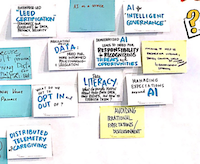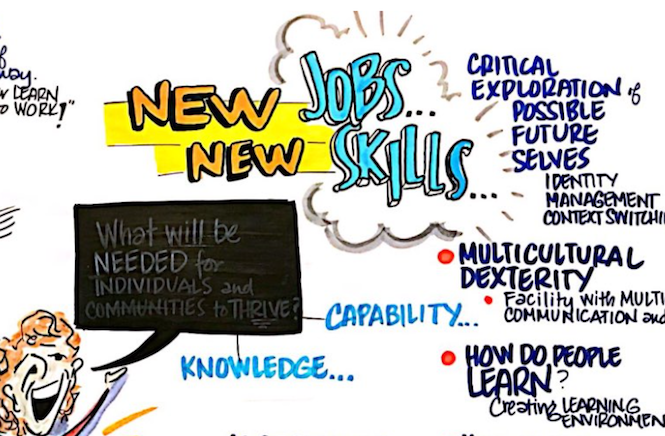Future Now
The IFTF Blog
Befriend the Machines to Get #futurefit—The Experts Weigh In
Machine intelligence is set to empower working learners.
Working learners are people of all ages who are working their way into better jobs by continuous preskilling, upskilling, and reskilling. Even without AI and smart machines, these working learners are already creating earthquakes in our educational systems. They’re disrupting the long-standing tradition of learn first, then work. Breaking out of this serial model of education and jobs, they’re working their way through learning, and learning their way into new work opportunities, starting early in life and continuing well into so-called retirement.
Now add in machine intelligence. It’s easy to cast AI as a threat to workers, out to steal their jobs and turn them into low-level maintenance workers for robots or skilled technicians for coding an artificially intelligent workforce. But the potential symbiosis between working learners and intelligent machines is so much more provocative: it calls on us to reimagine what humans can accomplish in an AI-rich world. And over the next decade, working learners will lay the tracks for this epochal reinvention.
The empowering future of AI skills
On April 23, 2018, the Institute for the Future, in collaboration with Lumina Foundation, assembled a roomful of experts in artificial intelligence, education, and the workforce to co-create possible visions of the human-machine future.
These experts represented organizations like Google, IBM, Facebook, Apple Education, AI4All, NetHope, Stanford University, Southern New Hampshire University, and the University of California, Berkeley, among others, and over the course of the day, they painted an aspirational picture of the AI future where intelligent machines empower workers and learners with everything from drag-and-drop interfaces for building their own AI apps to deep data literacy and even agent-supported curiosity. They probed the possible paths toward AI governance and a democratization of AI. And they foresaw the potential for the intelligent machines of 2030 to help communities anticipate and prepare for disasters, both natural and social in nature.
The insights of these experts challenged long-held assumptions about how to train the workforce and the relationship between work and income. They raised questions whose answers could ultimately reshape both learning and the labor economy. For example:
What are the least essential skills for the future? While most scans of the work+learn horizon focus on identifying the most essential skills for success, the experts started the day by cataloguing the least essential skills. No one was surprised to find tasks like repetitive learning and rote memorization on the list, but the experts also challenged the much-hyped value of coding and AI programming skills in a future where workers and learners can create their own AI apps from thousands of existing modules, using simple interfaces much they way they grab images from a Google search to create Powerpoint presentations today. Focusing on least essential skills helps us see where not to invest our individual and collective learning efforts.
Find out more and add your voice.
 Where and how will tomorrow’s workers and learners acquire the skills they really need? Experts were also tasked with responding and reacting to four distinct future scenario. It was clear from the ideas they generated that learning will happen anywhere and everywhere. AI apps and agents will support data collection, data analysis, and even pattern identification in real-time, wherever working learners find themselves. But deeper understanding of the artificially intelligent world—and how to put it to work on the big problems facing communities—will likely happen through socialization as people work together to test their ideas, develop prototypes, and engage intelligent machines in their solutions. In preparation for this future, today’s schools might shift to become community work+learn labs. We may think of them, perhaps, as a kind of AI-enhanced DIY workshop for solving physical, social, and economic problems that confront local communities or even communities connected around the world. In fact, a key role of intelligent agents may be to connect these communities and amplify their efforts.
Where and how will tomorrow’s workers and learners acquire the skills they really need? Experts were also tasked with responding and reacting to four distinct future scenario. It was clear from the ideas they generated that learning will happen anywhere and everywhere. AI apps and agents will support data collection, data analysis, and even pattern identification in real-time, wherever working learners find themselves. But deeper understanding of the artificially intelligent world—and how to put it to work on the big problems facing communities—will likely happen through socialization as people work together to test their ideas, develop prototypes, and engage intelligent machines in their solutions. In preparation for this future, today’s schools might shift to become community work+learn labs. We may think of them, perhaps, as a kind of AI-enhanced DIY workshop for solving physical, social, and economic problems that confront local communities or even communities connected around the world. In fact, a key role of intelligent agents may be to connect these communities and amplify their efforts.
Who is accountable for making sure individuals can thrive in this new economy? In a world where “one job for one person” is a thing of the past and institutionally sanctioned curricula give way to AI-personalized learning, the nature of existing social contracts between employer and employee, between teacher and student, and indeed between a government and its citizens will be renegotiated or revamped entirely. In the process, institutional assessment and evaluation could well shift from top-down to new bottom-up tools and processes for developing capacities, valuing skills, and managing reputation.
What’s next? A View from the East Coast
The April 23 convening of AI experts in Silicon Valley left a lingering question about whether there are differences in east coast versus west coast views of the AI future and the skills it will require. To explore these differences, IFTF and Lumina Foundation will continue the conversation in a second workshop later this summer at Southern New Hampshire University with a complementary group of east coast experts.
Take a look at the graphic recordings from the convening on the west coast and the one on the east coast.
The full report of both sessions, and the insights that emerge from them, will be released at the Close-It Conference on October 15 in Austin, TX. This convening of companies and organizations provides an opportunity to share a new vision of working and learning that increases equity and access for all. The report will map the skills that will empower working learners to befriend the machines and put them to work on some of the biggest challenges we face in the coming decades. It will also help organizations and the public sector get #futurefit for a world of human-machine intelligence.
See also IFTF’s map of peak performance zones and super skills to Get Fit for What’s Next.




